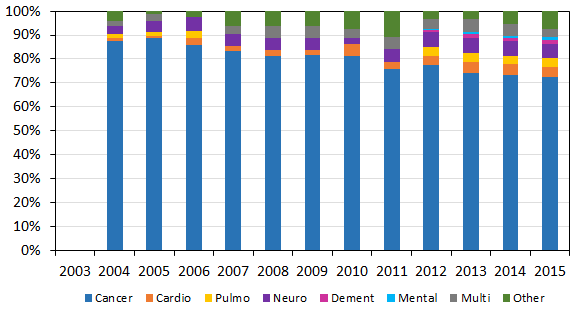Netherlands - 2015 euthanasia report card
In 2002 the Dutch Euthanasia Act came into effect. Commencing in 2003, the Netherlands Euthanasia Commission has published annual reports of deaths that occur under the Act. It has just published its annual report for the calendar year 2015. The data shows that the Euthanasia Act is working as the Dutch Parliament intended.
Number of assisted death cases
There were 5,516 reported cases of assisted dying in 2015, with 208 cases of patient self-administration and 5,277 cases of doctor administration. This is an overall increase of 4.0% on the 2014 figures (5,306 total cases). Assisted deaths represented 3.9% of all Dutch deaths in 2015.
Trend in assisted dying numbers
Comment has been made in past years about the rate of increase of assisted deaths in the Netherlands. The trend in number of cases of this nature was always likely to be an 'S'-shaped curve, a trend which the 2015 data supports as the annual increases level off (Figure 1) at a small percentage of all deaths.
Note: The Netherlands total deaths count for 2015 is not yet published: its value was estimated by extrapolation from previous years.
Figure 2 shows the year-on-year rate of change of assisted dying including a second-order polynomial best-fit trend line which illustrates that the rate of increase has slowed and the overall rate is leveling out.
Underlying health conditions
Cancer is by far the greatest underlying health problem affecting those who choose assisted dying in the Netherlands (Figure 3). This is unsurprising since cancer is now the leading cause of death in the Netherlands, accounting for 30% of all deaths.
Notes: Neuro=neurodegenerative diseases, Mental=mental illnesses other than dementia, Multi=multi-functional old-age decline, Other=all other illness types
While cancer accounts for the greatest numeric increase in reported assisted dying cases, other illnesses are increasing as a proportion of cases (Figure 4). Cardiopulmonary illness now underlies around 8% of cases (cardiac pathology is the second leading cause of death in the Netherlands) and neurodegenerative disease around 6% of cases.
 Figure 4: Underlying illnesses of Dutch assisted dying cases (proportion of illnesses)
Figure 4: Underlying illnesses of Dutch assisted dying cases (proportion of illnesses)
Multi-functional old-age decline underlies around 3-4% of cases. Untreatable mental illness is a rare health factor in Dutch assisted dying, with dementia present in 1 in 50 assisted deaths (2%) and other mental illness in 1 in 100 deaths (1%) .
Where assistance was rendered
Around 88% of Dutch people would prefer to die in their own home or similar care home, 10% in hospice and around 2% in hospital (Abarshi et al 2009). Those using assisted dying largely achieve these goals (Figure 5).
 Figure 5: Assisted dying place of death (proportion of assisted deaths)
Figure 5: Assisted dying place of death (proportion of assisted deaths)
Around 80% of assisted deaths occur in the patient's own home. Since the Euthanasia Act came into effect, the proportion of deaths occurring in hospices and in relative's homes ("other") increased from around 2.5% to 8% (an approximately 5.5% rise), and the proportion of deaths occurring in hospitals decreased from around 11% to 3.5% (an approximately 7.5% drop). There was a slight increase of less than 2% in the proportion of assisted deaths in residential care settings, and no increase in nursing home settings.
The data confirms that assisted dying patients are usually dying in their preferred location and that 'institutionalisation,' particularly in nursing homes, is not a risk factor for assisted dying as is sometimes claimed. The greatest change in place of death since the Euthanasia Act came into effect is a decrease in hospital deaths and a complimentary increase in hospice care deaths, reflecting good palliative care practice.
Standard of practice
Of the 5,526 assisted dying cases reported in 2015, 4 were judged by the Euthanasia Committees as not meeting all necessary due care criteria: a compliance rate of 99.93% and non-compliance rate of 0.07%.
Summary
- The 5,516 Dutch assisted dying cases for 2015 represents an increase of 4% on 2014 cases, and 3.9% of all Dutch deaths in 2015.
- The rate of increase has slowed in line with expectations.
- The great majority of cases involve cancer, the Netherlands' leading cause of death.
- Assisted dying under other medical conditions is uncommon or rare.
- Assisted dying usually occurs where the patient prefers, most often in their own home.
- Assisted dying has decreased in hospitals and commensurately increased in hospices, in line with good palliative care practice.
- The rate of compliance with all legal requirements in 2015 was 99.93%.
Some commentators have criticised the numbers of Dutch using the Euthanasia Act even though the rate remains a very small proportion of all deaths (3.9%). The question, however, is not 'how many', but whether these cases represent the contexts and circumstances the legislature had in mind when crafting the Euthanasia Act, which stipulates a raft of conditions and processes. It is clear that the legislature's intent has been upheld.
References
Abarshi, E, Onwuteaka-Philipsen, B, Donker, G, Echteld, M, Van den Block, L & Deliens, L 2009, 'General practitioner awareness of preferred place of death and correlates of dying in a preferred place: a nationwide mortality follow-back study in the Netherlands', Journal of Pain and Symptom Management, vol. 38, no. 4, pp. 568-77.
Regional Euthansia Review Committees (Netherlands) 2015, Annual report 2015, Arnhem, pp. 81.

 Figure 1: Netherlands assisted dying deaths as a percentage of all deaths
Figure 1: Netherlands assisted dying deaths as a percentage of all deaths Figure 2: Year-on-year change in the proportion of assisted dying cases
Figure 2: Year-on-year change in the proportion of assisted dying cases Figure 3: Underlying illnesses of Dutch assisted dying cases (proportion of all deaths)
Figure 3: Underlying illnesses of Dutch assisted dying cases (proportion of all deaths)